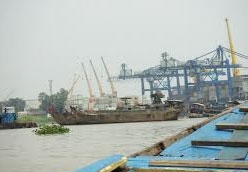Port plan in stormy seas
 |
| Saigon River ports illustration photo |
Under Decision 791/QD-TTg the deadline for Ho Chi Minh City to remove ports on Saigon River to the city outskirts was 2010. Affected ports were Tan Cang, Saigon Port, Ba Son shipyard, Ben Nghe and Tan Thuan Dong ports and some others. However, just Tan Cang was removed to Cat Lai and Cai Mep area.
Responsive to the city’s commitment to bringing ports to suburban areas in 2007 Ben Nghe Port Company pioneered in building Phu Huu port in Ho Chi Minh City’s District 9. Construction of the port finalised in July 2010, however, a road leading to the port and associated public utility systems such as power and water are not in place.
“We turned to the city’s management for remedial actions but progress was slow, wasting our investments. More importantly, the port is unused, failing to support economic development,” said a company executive.
Saigon Port is in the same situation.
According to Saigon Port deputy director Huynh Van Cuong, in May 2009 the company kicked-off construction of the first phase Saigon-Hiep Phuoc port in Nha Be district with over VND3 trillion ($145 million) in investment. Once active, the port will be accessible to 50,000 dead-weight-tonnage ships and handle Nha Rong-Khanh Hoi port functions.
However, the D3 road connecting Hiep Phuoc Industrial Park and Saigon-Hiep Phuoc Port is not built.
Capital scarcity is another big issue hindering port removal plans.
“To have capital for new port construction, it is important to change the land usage function of former ports,” said Ho Chi Minh City chairman Huynh Van Cuong.
For instance, Saigon Port authority plans to sell land under auction or call for investors to jump into its mixed-use development project. However, since Saigon River ports belong to Saigon River west bank urban centre, former ports’ land usage function change must await architectural approval from the city’s management.
Ho Chi Minh City Architecture and Planning Department Planning Information Centre director Huynh Xuan Thu said the urban centre design plan would be completed and submitted to the city’s management for consideration in late November.
Besides, massive investment into container terminals in recent years led to supply far outrunning the demand.
Ho Chi Minh City-based container terminals’ total capacity could reach seven million containers per year if proposed investment projects came online, according to Vietnam Seaport Association general secretary Ho Kim Lan. Meanwhile, total container loading capacity in southern area is forecast to be over four million tonnes in 2011 only and six to seven million by 2020.
What the stars mean:
★ Poor ★ ★ Promising ★★★ Good ★★★★ Very good ★★★★★ Exceptional
Related Contents
Latest News
More News
- Global partnerships key to Vietnam’s IFC development (December 26, 2025 | 16:18)
- Vingroup pulls out of bid to invest in North-South high-speed railway (December 26, 2025 | 11:42)
- Strengthening supply chains through trade promotions and customs reform (December 24, 2025 | 14:00)
- PM orders investment model for North–South high-speed rail (December 22, 2025 | 17:43)
- LS Eco Energy to invest in Vietnam rare earth sector (December 22, 2025 | 17:31)
- Government moves to establish International Financial Centre (December 21, 2025 | 21:00)
- Vietnam's IFC to target global investment flows (December 21, 2025 | 18:00)
- Two national hospitals expand capacity with new facilities (December 20, 2025 | 09:00)
- Ha Tinh breaks ground on major Vingroup industrial and energy projects (December 19, 2025 | 18:24)
- EVN launches major power infrastructure projects nationwide (December 19, 2025 | 18:17)

 Tag:
Tag:





















 Mobile Version
Mobile Version